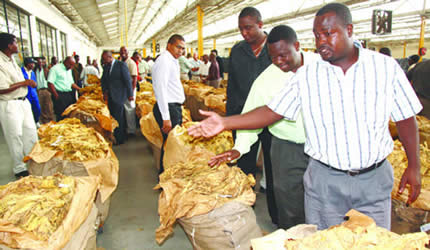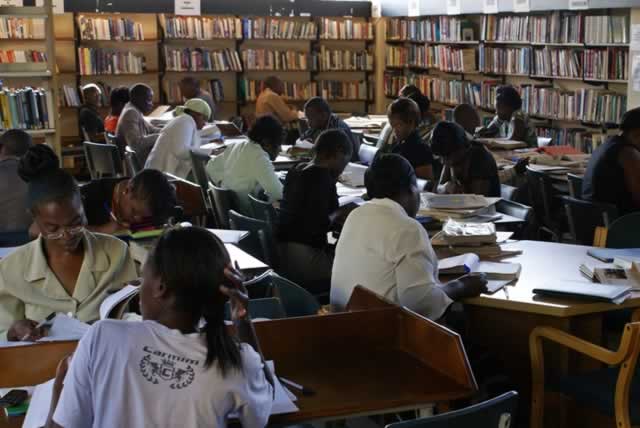Tobacco to ease liquidity crunch


About 86 000 farmers registered to grow flue-cured tobacco in the 2013 /14 summer cropping season compared to the 64 700 registered in the 2012 /13 season. The increase in growers will likely boost revenue
Business Reporter
THE tight liquidity pervading the entire economy could significantly improve in a few months due to anticipated tobacco export inflows with the tobacco marketing season scheduled to begin in mid-February.
According to the Tobacco Industry and Marketing Board, the flue-cured tobacco marketing season will start on February 19, although TIMB is yet to come up with a projected earnings figure. Last year, the country earned more than half a billion dollars from tobacco exports.
Zimbabwe could surpass last year’s earnings after deliveries of 166,5 kilogrammes, considering that the 97 000 hectares under crop represent 25 percent increase on prior year.
Traditionally, the tobacco marketing season has been associated with improved liquidity on the market even during the prosperity years of the mid 90s when the central bank would battle to control excess liquidity in the market induced by foreign currency inflows from the golden leaf.
Tobacco had a positive effect on domestic liquidity as forex inflows were liquidated into Zim dollars usually pushing down local interest rates. The open market purchases also boosted the Reserve Bank of Zimbabwe’s forex reserves, allowing the apex bank to build a foreign currency buffer for the economy for selling back to the market during the leaner months
This could come in handy for Zimbabwe as tobacco exports have grown to become a major foreign currency earner at a time when most other traditional sources have significantly waned.
TIMB chief executive Dr Andrew Matibiri corroborated the assertion in an interview yesterday saying the onset of the selling season could ease liquidity as exports bring in fresh liquidity.
“The money buyers use has to be fresh money and when new money comes into the economy the liquidity issue will be addressed, buyers are not allowed to borrow from local banks,” he said. “According to foreign exchange rules, they have to bring money from outside,” Dr Matibiri said.
The TIMB CEO said the tobacco industry regulatory board conducts regular checks on the buyers’ bank accounts to see if they are still liquid and if not they are quickly de-registered.
Dr Matibiri said TIMB expected deliveries of early planted tobacco, usually irrigated crop planted in early September, in February, but it was too early to know how much the crop will rake in this year.
This was because Zimbabwe had experienced a delayed rainy season, meaning that a significant proportion of the crop was still in the early stages. However, TIMB expects to have a picture of potential tobacco export earnings this year in the next four weeks.
Overall, the benefits from the increased tobacco export earnings may be short-lived for a country that imports the bulk of products it consumes due to constrained agricultural and industrial production.
The country’s trade deficit in the 11 months to November 2013 rose to US$3,89 billion. In the 11 months, the Zimbabwe National Statistical Agency said, the country imported products worth US$7,15 billion dominated by fuel, fertilisers, second-hand car imports and textiles.
According to Finance Minister Patrick Chinamasa tobacco output increased by 15 percent from the 2012 production level of 144,5 million kg, to about 166,6 million kg in 2013, from some 88 623 hectares put under crop. Last year, Zimbabwe produced 153,3 million kg of tobacco, realising US$877 million in revenue.
In 2014, tobacco production is projected at 170 million kg, a 2,6 percent increase from the 2013 output. This growth is mainly on account of increased planted area of about 90 000ha from the 88 600ha in 2013.
Furthermore, 86 000 farmers registered to grow flue-cured tobacco in the 2013 /14 summer cropping season, from the 64 700 registered in the 2012 /13 season.
Tobacco seed sales also increased from 803 000 grammes last year, to 1 024 000 grammes this year. The seed is expected to cover close to 170 600 hectares. In terms of financing, production will be underpinned by farmers’ own resources, contract farming and bank funding arrangements.
Contractors include the Chinese company — Midriver Enterprises — which is expected to contract nearly 80 000 farmers to produce flue-cured tobacco.
While the tobacco marketing season is set to start on February 19, contract tobacco sale will begin the next day. Bookings will start on the 5th and deliveries from February 12. For the rest of 2014, all tobacco is required to be booked first before delivery, TIMB said.











Comments